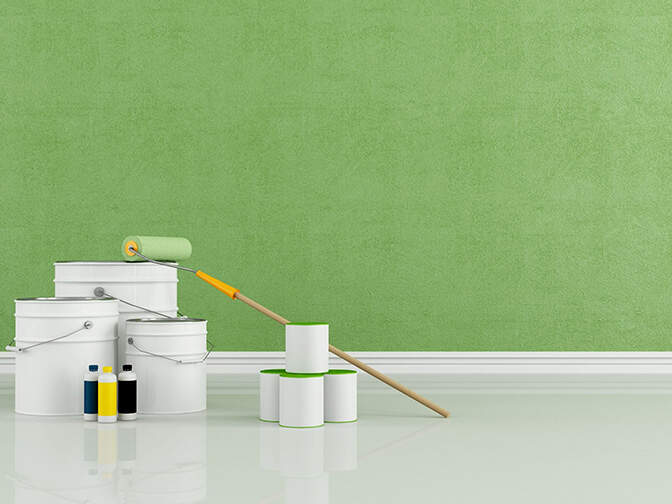It has been a common knowledge that painting contributes to the overall look of buildings. In fact, painting is one of the basic elements for renovation projects. And for painting professionals, paints have additional uses and applications beyond enhancing the entire appearance. That is why it is crucial for the painting professionals to know more about every type of paint’s performance features. Through that way, it’s easy to determine the best paint product for every application. Furthermore, one also crucial thing that painting contractors have to consider is the application of construction scheduling software. Painting services and the work they offered are best supervised and organized using this software tool.
In this blog, the painting’s main purpose, its different types, and applications are going to be further discussed.
Main Purpose of Painting
Paint has been around for many years. Quality and texture of paint are continuously evolving as years passing by. Buildings, facilities and even at home are where paint usually applied. For buildings, the major reason why it has to be painted is to protect its exteriors and interiors. Elements like UV rays, molds, wind, stains and water penetration often affect the buildings, and basically, paint is used as outside protection. There is a distinction between a low-quality paint and an excellent quality of paint. Painting professionals are very specific when it comes to this matter. The need to use excellent quality paints are very crucial to the surface performance of buildings. These painting experts are also particular in using construction management software. Achieving comprehensive team collaboration and solid teamwork is easy using this software tool. In fact, the overall team productivity is increased. The different features this tool has provided are perfectly suited to the needs of contractors and subcontractors.
We will see why and how good quality paint is purposely created and why it is preferably used in many industries, particularly in construction. Painting is typically carried out for the following reasons:
· Simple maintenance – surfaces and areas that are well-painted are much easier to clean
· Provides protection to surface against from solar radiation, insects, rain and other external factors
· Improving the visual appeal of the surface
· Improving surface durability
· Waterproofing
For project managers, they are required to have a thorough knowledge about this area of expertise. They have become much updated with all of the latest trends and at the same time become engaged in using a particular project managers software. Work has been so much easier using this tool, tasks are more organized, and the crew members are well-supervised using this software application.
Going further, before choosing the type of paint to use, it’s essential to consider the physical properties of it. An excellent type of paint will efficiently offer the following benefits:
· Forming a durable and hard coating
· Ease of application
· Formation of thin-film w/o cracking
· Reasonable or excellent drying period
· Not very harmful for users
· Its main performance must not get affected by weather conditions
What Makes Paint an Excellent Quality?
What originally makes a paint an excellent one in terms of quality? This is probably one of most asked questions. Painting contractors are very meticulous in choosing the best painting products and implementing the best paint methods and practices in order to exceed client’s expectations. But today there are software technologies available for them to use that could definitely help in managing painting projects and services, and thus, an easy way to achieve the goal they have set for their clients. A software application like builders schedule software is one of the software technologies uses today. Real-time collaboration, faster scheduling of tasks and efficient supervision for any painting projects and services are best achieved through the use of this application. Good quality of paint is not just the only thing that is worth investing but also software tools like crew schedule software.
The major difference between low-quality paint and excellent-quality paint is definitely the number of components that are being comprised to it. To be clear, an excellent-quality paint mix is consists of:
· Pigment: 20%
· Solvent: 15%
· Binder: 40%
· Extender: 20%
· Additive: 5%
Note that an excellent-quality paint is believed to be not porous and that only means that water doesn’t absorb into the paint, instead it will only simply runs it off. Paints that are lower in quality let the water absorb so quickly towards the porous paint resulting in peeling and bubbling in no time at all. An increasing percentage of binders and pigments in the paint can cause the price to accelerate. However, the paint’s long-lasting effect ultimately outweighs the cost of getting more repainting. Higher- quality paint definitely is worth investing because repainting will not be done every single time but only when it is very necessary and urgent.
Different Types of Paints
1. Enamel Paint
This particular type of paint is commonly produced by adding zinc or lead straight to varnish. In order to achieve a vast array of colors, pigments are going to be added onto it. Enamel paints are proven to form hard and glossier coatings that are absolutely easy to clean. Additionally, the paint is characterized by being chemically resistant and waterproof, offering excellent color retention and good coverage. Subcontractors must be supervised properly during the application process of this paint. A subcontractor scheduling software is an excellent project and crew management tool that ultimately helps the entire project cycle and all crew members involved.
Below are some of the most common uses of enamel paint:
· Windows
· Interior and exterior walls
· Stairs
· Wood trims, flooring, doors
· Surface areas like masonry, metals, wicker, glass and plasters
The major limitations when it comes to enamel paint are the requirement of titanium coating and slow drying before application.
2. Oil Paint
Oil paints usually use white lead as its base and are usually applied in 3 coatings – primer, undercoat, and lastly finish coat. This type of paint can greatly achieve glossy and mat finishes and at the same time while being durable and affordable. The painted surfaces after using oil paint are very easy to clean and it is also characterized by ease of application. Oil paint is typically used indoors, metal structures, walls and windows. It is important to take note that oil paint isn’t suitable most particularly for humid conditions and it also take so much time to dry out completely. For its application, linseed oil and pigments should be added beforehand.
3. Emulsion Paint
Emulsion paints often use polystyrene and polyvinyl acetate as its binding materials, and at the same time, it contains driers such as manganese and cobalt. Furthermore, this paint can either be oil-based or water and its pigments are often used in order to achieve all desired colors. Emulsion paints are typically characterized by its hardening and fast-drying capabilities. For the surfaces, it can be easily cleaned using water. After the application, the paint itself definitely offers good color retention, durability and lastly alkali resistance.
4. Cement Paint
This type of paint is neither water nor oil-based but usually available in powder form, mixed using water to achieve paint consistency. The very base material for this is either colored cement or white and it might also contain pigments, other additives, and even accelerators. Cement paint is commonly used in both rough external and internal surfaces since its characteristics are proven to be very durable and waterproof. Take into consideration that cement has longer drying time, usually for about 24 hrs. The application for it should be done in two coatings in order to prevent dampness issues.
5. Bituminous Paint
This specific type of paint is usually made from tar or dissolved asphalt that ultimately gives it a common characterized black color. It is also waterproof and at the same time alkali-resistant. However, it is not suitable for any applications wherein it will be fully exposed to the sun because it gradually deteriorates. Bituminous paint is typically used for concrete foundations, underwater ironworks, iron pipes, and wooden surfaces. For metal application, it helps in providing rust resistance.
6. Plastic Paint
This type of paint often uses water as the thinner, and this is very much available in a wide-ranging set of colors. The way it dries is quick and it certainly offers very high coverage. Below are the common applications of plastic paint:
· Slabs
· Ceilings, walls of display rooms, auditoriums, showrooms, etc.
· Decks
7. Anti-Corrosive Paint
This paint is often characterized by its own chemical resistance as being implied with its name. Linseed oil, fine sand and zinc chrome are where it has been made of. This paint has a normal black color and often apply for pipes or any metallic surfaces. This paint is capable of obstructing the corrosion by minimizing the direct access of water and air to the metal. The coatings act as a barrier in order to inhibit the main contact between corrosive materials and chemical compounds.
8. Cellulose Paint
This paint is commonly produced from amyl acetate, celluloid sheets and photographic films. Adhesion could be improved through the addition of castor oil and the surfaces could be cleaned easily. Once the paint has dried, it can be washed too. This particular kind of paint is usually characterized by its faster drying, hardness and smoother finish while it offers resistance against water, acids, and smoke. Cars and airplanes are where cellulose paint is best applied. It is absolutely the cost that turned out to be the greatest disadvantage of this paint. Nevertheless, still, it is worth investing.
Key Takeaways
As stated and explained above, several types of paints are widely available right now and its applications are in wide variations as well. The many reasons for using paint in the construction industry include surface durability, pest protection, chemical protection, and visual appeal. Every type of paint is purposely designed for many specific applications. It is also a good thing to remember that the selection of excellent-quality of paint can ultimately reduce project costs while the performance is consistently improving.





